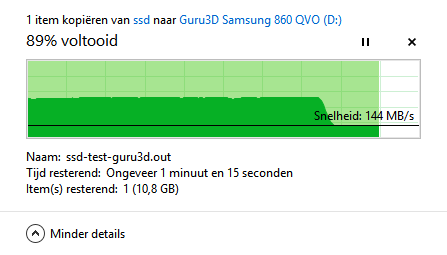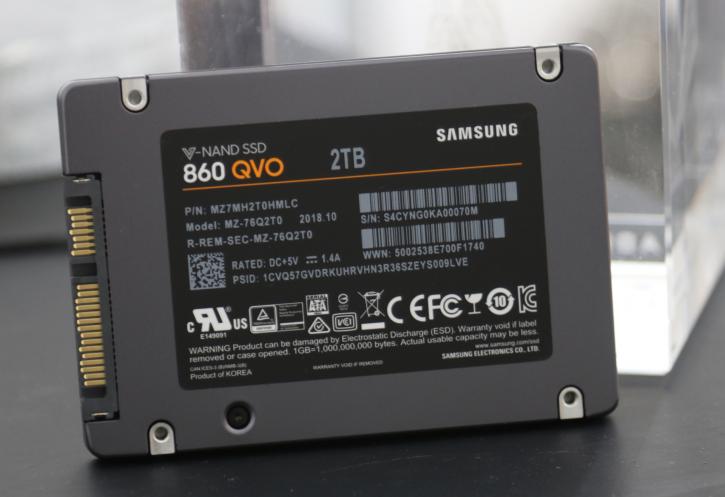Final Words & Conclusion
Final Words & conclusion
Starting today, the SSD market is going to change for the better, prices will go down. If you are in the market for a SATA3 SSD and want proper value for money, hey you've reached the end of your searching destination. A terabyte of storage at will cost 149 USD (which is an MSRP) and that is a modest step in the right direction that the industry needs so hard.
QLC write hole
Much like TLC, QLC faces some challenges writing more bits per cell of NAND, we noticed a dropoff in performance with mixed heavy workloads that exceed writing dozens of gigabytes continuously. Basically, QLC on this SSD writes at 150 MB/sec. However, Samsung bypasses that by taking a chunk of NAND, and writes that NAND at SLC (1-bit per cell). This is nothing new and called your provisioning cache buffer. pretty much all manufacturers do this. The 1 TB QVO has 42 GB of SLC cache, and the 2 and 4 TB QVO versions get 78 GB caches. That solves the write performance drop 100%, this SSD is not any slower than the EVO for example.
110 Gigabyte File copy @ 78 GB performance drops
However, AFTER you pass that 78 GB of writes (and I do mean continuous sustained/linear writes minute after minute, then the SLC buffer is full and start to write directly to QLC, and then perf drops to ~150 MB/sec. After a few minutes the SLC cache will have written out and boom, performance is back at ~ 500 MB/sec ranges. This, in a nutshell, is what you need to be aware of with TLC and QLC SSDs. For the 2TB version tested, I mean how often do you really write that much data at once? Yep, so for us, this is pretty much a non-issue, especially considering we've now reached the upper ultra value segment of the market. And if you have complex writing workloads, a PRO series SSD would be more suited.
Performance
I guess I already addressed the Achilles heel. This SSD writes and reads serious amounts of tiny files in a fast enough fashion. You can often notice a drop-off point once the caches really run out of stamina, but you will need to have written so many GBs before that happens. IOPS is not something you as a consumer should worry about too much unless you are doing a lot of database related work or create similar workloads on your PC, but this SSD certainly ranks high within this aspect. Trace testing - we think by far the best test in our entire benchmark suite is PCMark. This is a trace test and can emulate what you guys do on your PC but then multiply it by a factor of 100, this test puts more focus on read performance as opposed to writing though. Zoom in at both IOPS and trace performance and you'll notice that the SSD can manage serious workloads without breaking so much as a drop of sweat. So whether you write lots of small files, copy MKV movies or do it all together, the SSD remains a solid performer on all fronts. So overall the unit is very fast for a SATA3 storage unit, I did not expect that from QLC writes. But as mentioned, the write performance is really based on the buffers that Samsung creates, the SLC written provisioned cache, and a nice SDRAM assist as well. You will pass a 40 GB writes on a 1TB SSD without noticing a drop in performance, that's 78 GB for the 2 and 4 TB versions. however, once it does kick in, it'will kick in card and perf can drop towards 150 MB/sec in such a setting. But with the cache in place, I find this a very trivial remark though as really, the chances you'll run into it are really slim.
Overall
Right, an or any SSD anno 2018/2019 is enjoyable. Very much so. If you put a drive like this into your SATA 3 compatible laptop or SATA 3 compatible PC, you'll have no idea what is about to hit you when comparing with an HDD. We very much enjoy the grand sustained performance of this SSD series. Make no mistake, replacing an HDD with an SSD in your desktop PC or laptop eliminates the random access lag of the HDD head, it is no longer mechanical. That, combined with the maxed out performance SATA 3 offers these days, is simply a massive difference and probably the best upgrade you can make for your computer this day and age.
Price point
Fabbing your own controller, PCB, cache chips, and own NAND flash memory does have advantages as Samsung is able to keep the prices competitive as this product is made 99% in-house (perhaps they outsource the stickers I don't know ;)
- 4TB - $599 (= price expected, but TBA)
- 2TB - $299 (= price expected, but TBA)
- 1TB - $149 / £136.99
Prices are in the value range relatively speaking and closing in on HDD values, 299 USD for a 2 TB model. So that's roughly 15 cents per GB, perhaps even lower when they get available as these are suggested retail prices, not even the street prices. Your warranty is 3 years, the endurance values are quite reasonable. Here, bigger is better, of course.
Concluding
It is good to see the first QLC SSDs on the market. QLC, my friends, has been introduced to become the most price competitive NAND type in the industry, read my words QLC (and more layered 3D NAND) is the final nail to the coffin of the HDD. I say fantastic as QLC NAND (4-bits written NAND) is going to be the game-changer in the near future. The denser written NAND cells allow for more storage inside that same package. The proper example is the product tested today as really, it performs as good as the EVO does. That said, Samsung faces a couple of challenges, the end-users will not likely 'trust' QLC in terms of a number of writes and reliability. We have seen exactly the same with TLC, which now is an accepted NAND storage standard. The TWB values are okay, Samsung, however, tops this unit off with a 3-year warranty. Imho that should have been 5 years as QLC needs that in terms relation towards consumer trust for it to take off and to get commonly accepted and trusted. Samsung tweaked the controller a bit and applied new vertically stacked QLC NAND, 64-layers of them. This results in SSDs ranging from 1TB up-to a staggering 4 TB. Our tested 2 TB version simply offers good performance, continuously in that 500 MB/s sweet spot. Performance wise it's mostly, all the same, these days, ergo the biggest move in the storage industry right now is the quest for more capacity and proper endurance with SATA3 6 Gbit/s storage units. For the first QLC SSD drives tested we are not disappointed.
The pricing is and will be decisive, Samsung will be asking 15 Cents per GB and the way I see it, that number needs to come down further though. We feel 10 cents per GB is where we need to be as right now for this money you can purchase a TLC NAND SSD for the same money just as well. TBW values are okay, this 2TB SSD is rated at 720 TB. So if you write 50GB per day the SSD would last 39 years, I would be comfortable with such a value personally. Of course, the longevity in TBWs is thanks to the high volume sizes. But once the QVO models get available, I would not even hesitate to mount them into sat a game PC, laptop or even NAS (a 10 Gbit/s one of course;). Yeah, that's it for this review, you guys. Today you have met the value storage future, and its name is QLC based NAND. It is impossible to not recommend this product series at these prices and performance figures. And you know it, once Samsung makes this move, others will follow in price. We'll have to wait and see how it all pans out with street prices, but this is a good development.
Note: Samsung updated (increased) its pricing shortly before the launch. We have updated this article to reflect the new price tag. At this time the EVO makes more sense. Also, we've been informed that the 2TB and 4 TB unit will become available as late as February 2019. The 1TB unit will be available starting mid-December.
Recommended Downloads
- Sign up to receive a notice when we publish a new article
- Or go back to Guru3D's front page



